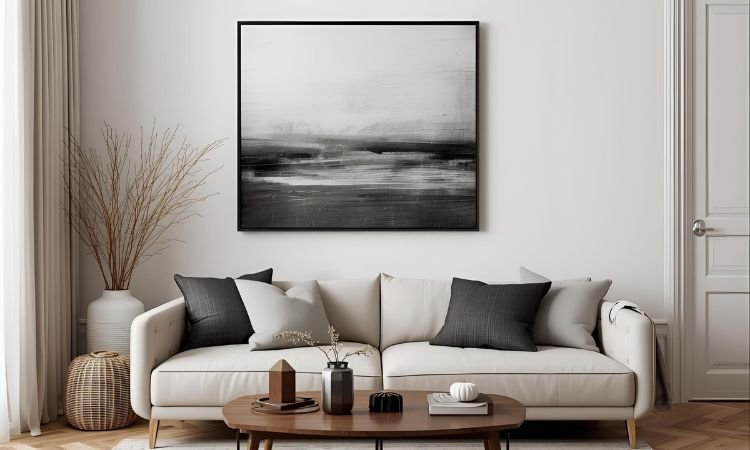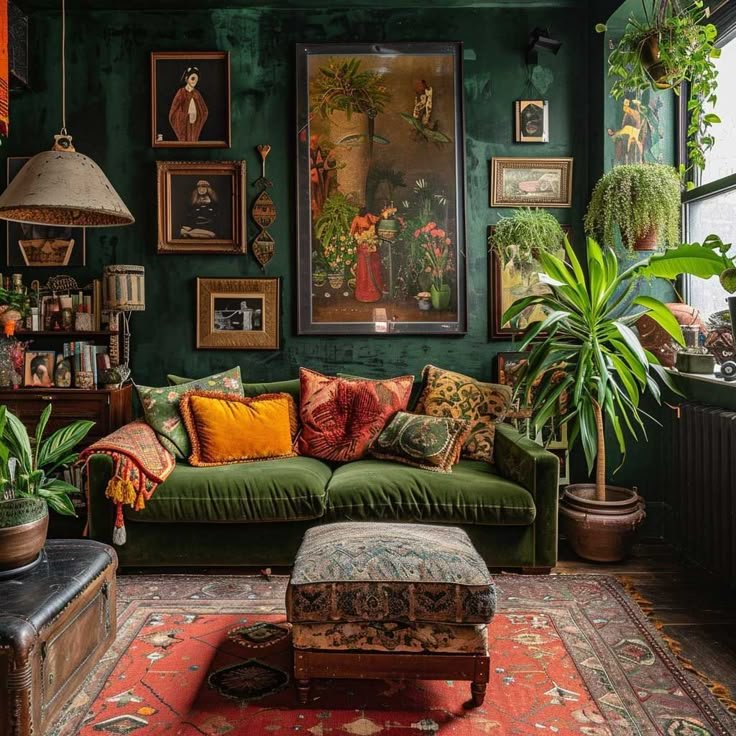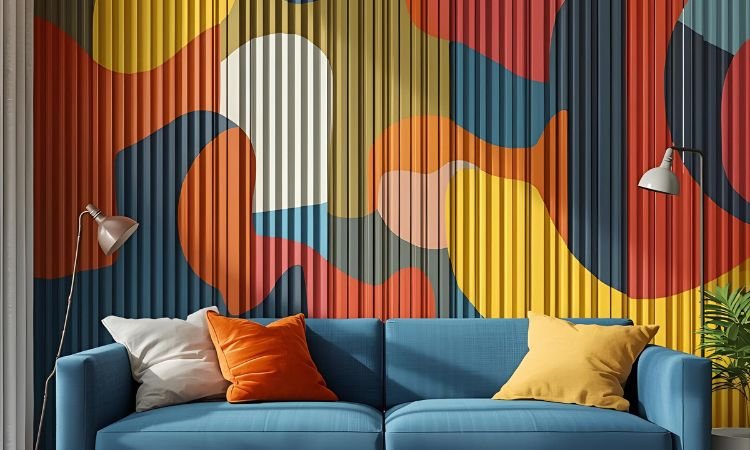
You’re going for that clean minimalist look, but your living room walls just feel bare and unfinished. There’s this fine line between intentionally minimal and “did they just move in?” and honestly, it’s tricky to nail. Too much stuff ruins the whole vibe, but too little makes the room feel cold.
Minimalist wall decor isn’t about having nothing on your walls. It’s about choosing fewer pieces that actually matter, making sure everything earns its place, and letting negative space do some of the work. The best minimalist rooms feel calm and complete, not empty and sad.
Here’s what trips people up. They think minimalist means generic or boring, so they either go too safe or they overthink it. Then you end up with that one piece of abstract art that cost a fortune but doesn’t really do anything for the space. Or worse, walls that look like you gave up halfway through decorating.
I’m breaking down 11 minimalist wall decor living room ideas that actually create that balanced, intentional look. You’ll see how to choose pieces that work, where to position them for maximum impact, how much is actually enough, and ways to keep things interesting without cluttering up your carefully curated space.
What Makes Minimalist Wall Decor Actually Work
- Quality Over Quantity Changes Everything: One substantial piece beats three mediocre ones every time. It’s like capsule wardrobes where fewer better items work harder. The investment in good pieces shows while cheap multiples just look cluttered.
- Negative Space Has Purpose: Empty wall isn’t wasted space—it’s part of the design letting your eyes rest. It’s like pauses in music where silence makes sound matter more. The breathing room makes displayed pieces feel more important.
- Scale Creates Impact: Minimalist spaces need appropriately sized pieces making statements without extra decoration. It’s like jewelry where one bold piece works better than layering small ones. The substantial scale prevents minimal from feeling skimpy.
- Cohesive Color Palette Unifies: Limiting colors across all wall decor creates harmony minimalism requires. It’s like painting where restricted palette feels sophisticated. The color discipline makes everything look intentional instead of random.
Minimalist Wall Decor Living Room Ideas
Create calm, intentional living spaces with these minimalist wall decor approaches that balance simplicity with visual interest.
Single Large-Scale Abstract Art
Hang one oversized abstract piece as sole focal point on main wall. The substantial size commands attention while clean composition maintains minimalist vibe. I’ve found this works especially well over sofas where one 60×40 inch piece beats gallery wall every time for minimal aesthetic.
Choose neutral palette—blacks, whites, grays, beiges—or single color accent matching room. Abstract shapes avoid busy details keeping things calm. Quality canvas prints cost $150-400, original art runs $500-2,000+. Frame in simple black, white, or natural wood. That’s it—one piece, done.
Floating Shelves with Minimal Styling
Install one or two floating shelves displaying carefully curated objects. The horizontal lines add architectural interest while shelves hold minimal decor. We’re talking 3-5 objects maximum per shelf, not crowded collections.
Choose sleek white, black, or natural wood shelves 36-48 inches long. Display single vase, small sculpture, coffee table book, or simple plant. Costs $30-80 per shelf plus $20-100 for objects. The restraint here makes each piece feel special. Resist urge to fill every inch—half-empty shelves look more intentional.
Black and White Photography Series
Display 2-3 black and white photographs in matching simple frames. The monochrome palette and repeated framing create cohesion without complexity. This works great in grid arrangement or linear row at same height.
Choose large formats—16×20 or 20×30 inches minimum. Architectural shots, landscapes, or abstract compositions work better than busy scenes. Frame in matching matte black or white. Professional prints cost $100-200 each framed. Space 4-6 inches apart maintaining clean lines. The repetition creates impact through simplicity.
Oversized Round Mirror
Hang substantial circular mirror as sole wall feature. The geometric shape adds interest while mirror reflects light keeping space bright. Round mirrors soften angular rooms without needing additional decoration.
Choose 36-48 inch diameter in simple frame—thin black metal, brass rim, or frameless beveled edge. Position above console, centered on blank wall, or offsetting sofa. Costs range $150-500 for quality pieces. The single curved element provides enough visual interest making other decor unnecessary.
Linear Metal Wall Sculpture
Mount slim metal sculpture creating horizontal or vertical lines. The three-dimensional element adds texture without visual weight. These work beautifully in modern minimalist spaces wanting something beyond flat art.
Choose abstract geometric designs in matte black, brushed brass, or natural metal. Sizes vary but 30-48 inches long works for most living rooms. Expect $100-300 for quality pieces from West Elm, CB2, or AllModern. The dimensional quality catches light throughout day adding subtle movement.
Single Statement Plant Wall Mount
Install wall-mounted planter holding one substantial plant. The living element adds life and texture while maintaining minimal footprint. I mean, even minimalists need something organic breaking up all those clean lines.
Choose architectural plants—fiddle leaf fig, monstera, snake plant—in simple ceramic or concrete planter. Wall-mount planters cost $40-100, plants run $30-80 depending on size. Position strategically where greenery balances other elements. One plant beats several small ones maintaining minimal aesthetic.
Textured Neutral Wall Hanging
Hang woven wall hanging, macramé piece, or textile art in neutral tones. The organic texture adds warmth without color or pattern complexity. This softens minimalist spaces that can feel too hard or cold.
Choose natural materials—cotton, jute, linen—in creams, tans, or grays. Sizes typically range 24-36 inches wide. Costs vary $50-200 for handmade pieces from Etsy or boutiques. The texture provides visual interest while neutral palette maintains minimalist discipline. Position above credenza or on accent wall.
Minimalist Line Drawing Art
Display simple line art featuring flowers, trees, or abstract forms. The clean single-line compositions feel modern and intentional. These have been everywhere lately but work really well in minimalist spaces.
Choose 18×24 or 24×36 inch prints in black on white or white on black. Frame simply in thin black or natural wood. Multiple pieces work if arranged in clean grid maintaining space between. Affordable prints cost $30-80 each, originals run $200-500. The simplicity prevents overwhelming space while adding personality.
Architectural Clock as Focal Point
Mount oversized minimalist clock as functional wall art. The clean design serves purpose while making visual statement. It’s like when décor actually does something instead of just sitting there.
Choose 24-36 inch diameter with simple face—just lines, no numbers, or extremely minimal numbers. Black and white, all black, or natural wood and brass combinations work best. Costs range $80-300 for quality versions. The functional aspect makes single-piece approach feel less sparse. Plus you can actually see what time it is from across the room.
Ledge Shelf with Rotating Art
Install picture ledge displaying 1-2 pieces of art you can easily swap. The flexibility lets you change things without new holes in walls. This works great for commitment-phobes or people who get bored easily.
Mount 36-48 inch ledge in white, black, or wood holding artwork leaning casually against wall. Display single large piece or two medium pieces. Ledge costs $30-60, rotate art from closet collection or swap seasonally. The changeable approach keeps minimalist space feeling fresh without permanent decisions.
Monochromatic Framed Prints Grid
Arrange 4-6 matching framed prints in symmetrical grid. The repeated frames and coordinated palette create impact through pattern while remaining minimal. This fills larger walls without overwhelming them.
Choose same-size frames—12×16 or 16×20 inches work well. Use identical mats and frames in black or white. Images should share color palette or theme—all landscapes, all abstracts, all botanicals. Space evenly in 2×2 or 2×3 grid with 3-4 inches between. Total cost $200-400 for prints and frames. The uniformity reads as single installation rather than collection.
Styling Minimalist Walls Successfully
- Leave More Space Than Feels Comfortable: Your first instinct is probably to add more, but resist. It’s like seasoning food where you can always add but can’t take away. The extra negative space distinguishes minimalist from just-decorated.
- Invest in Fewer Better Pieces: Skip the HomeGoods clearance section and save for pieces you actually love. It’s like furniture where one great sofa beats three mediocre chairs. The quality pieces elevate entire space.
- Maintain Consistent Frame Style: If using multiple frames, match them exactly or choose complementary minimalist styles. It’s like hardware where consistent finish matters. The cohesion prevents visual chaos minimalism avoids.
- Consider the Whole Wall: Don’t just focus on the piece—think about how much empty space surrounds it. It’s like photography composition where background matters as much as subject. The ratio of filled to empty space determines success.
Frequently Asked Questions About Minimalist Wall Decor
How Much Wall Space Should Stay Empty?
Aim for 60-70% of wall space remaining blank in truly minimalist rooms. That feels like a lot—because it is. But that’s what makes minimalism work. The negative space lets displayed pieces breathe and makes them feel more significant.
If you’re transitioning from maximalist style, start with 50% empty and see how it feels. You can always remove more pieces. Going too minimal too fast might make you uncomfortable and you’ll just add stuff back.
Does Minimalist Mean Everything’s Black and White?
Not at all, though neutral palettes do dominate minimalist style. You can absolutely include color—just use it intentionally and sparingly. One colorful piece against neutral walls makes more impact than multiple colorful items competing.
Think muted tones rather than bright primaries. Soft terracotta, sage green, dusty blue, or warm gray add personality without overwhelming. The key is restraint, not elimination of all color.
Can You Mix Different Art Styles?
Technically yes, but it’s harder in minimalist spaces. The limited number of pieces means each one stands out more, so clashing styles become really obvious. If mixing, keep color palette consistent—all black and white, all earth tones, all monochromes.
Safer bet? Stick with one style or medium throughout. All photography, all abstract art, all line drawings. The repetition creates cohesion minimalism needs. Save the eclectic mixing for maximalist spaces where it works better.
Where Do You Find Good Minimalist Art?
Etsy has tons of affordable minimalist prints—downloadable files you print yourself cost $5-15, shipped prints run $30-100. Minted and Desenio specialize in modern minimalist art. West Elm, CB2, and AllModern carry curated selections fitting the aesthetic.
For original pieces, check local art fairs, Instagram artists, or Saatchi Art online. Expect $300-1,000+ for originals. But honestly, quality prints work great in minimalist spaces. The framing and presentation matter more than whether it’s original or reproduction.
How Do You Keep It From Feeling Cold?
Add texture and organic elements preventing sterile feeling. Wood frames instead of metal, woven textiles instead of canvas prints, plants alongside art. The natural materials warm up clean lines without adding visual clutter.
Also consider warmer neutrals—beige, cream, warm gray—instead of stark white and black. The softer palette feels more inviting while maintaining minimalist discipline. Lighting matters too—warm bulbs feel cozier than cool white LEDs.
Creating Your Minimalist Space
Minimalist wall decor living room ideas prove that less really can be more when you’re thoughtful about what stays. The carefully chosen pieces make bigger statements than crowded walls ever could. And honestly, the calm feeling you get from uncluttered spaces is worth the discipline required.
Start by removing everything from your walls. Live with blank walls for a few days seeing how it feels. Then add back only pieces you genuinely love, placing each one intentionally. The subtractive approach creates true minimalism instead of just sparse decoration.
What’s hardest for you about minimalist decorating—choosing what to keep or leaving walls emptier than feels natural? I want to hear what’s tripping you up!






